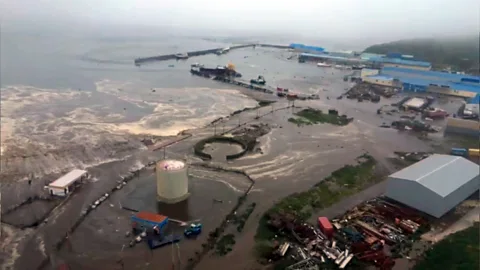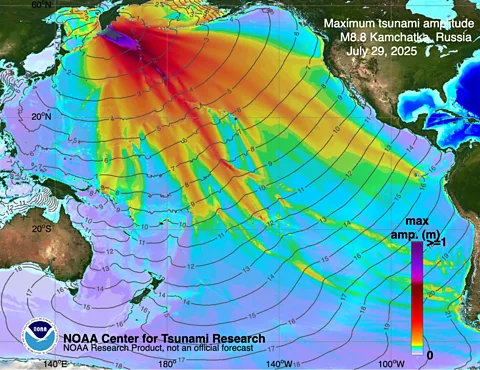'It sounded kind of crazy': How ripples in the high atmosphere warned scientists of a tsunami in real time
 Getty Images
Getty ImagesTsunamis are notoriously difficult to spot on the open ocean as they race towards shore. But in the summer of 2025, scientists watched one unfold as it happened.
It was the most powerful earthquake anyone had seen for nearly 15 years. It struck off the far eastern coast of Russia's Kamchatka Peninsula in July 2025 – an 8.8 magnitude quake that also triggered a tsunami with waves racing outwards at more than 400mph (644km/h). Within minutes, alarms sounded in communities around the Pacific Ocean.
Millions people were ordered to evacuate in the tense hours that followed, including at least two million in Japan alone. But as the wave propagated out across the ocean, it triggered something other than just fear – it created ripples in Earth's atmosphere.
The ocean, moving up and down across such a vast area, was disturbing the atmosphere above it and messed with global satellite navigation signals. But this disturbance also allowed scientists to spot the tsunami almost in real-time.
Purely by chance on the previous day, US space agency Nasa had added an artificial intelligence component to a disaster alert system called Guardian, enabling it to flag major events to scientists automatically. Roughly 20 minutes after the Kamchatka earthquake happened, tsunami-watchers knew that waves were heading for Hawaii, 30 to 40 minutes before they arrived.
Fortunately fears of widespread damage from the tsunami were not realised on this occasion. The waves that hit Hawaii were up to 5ft (1.7m) high, causing only minor flooding and no severe damage. Most of the tsunami's energy dissipated in the open ocean while the largest waves hit unpopulated areas. But had it been worse, those extra minutes of warning could have been crucial.
The episode proved that Nasa had a system that can, given the right conditions, detect a tsunami well in advance of its arrival on a coastline – just by listening to radio signals used by orbiting global navigation satellites as they communicate with ground stations on Earth. The same approach can even detect volcanic eruptions, rocket launches and underground nuclear weapons tests.
"They were able to say in pretty much real time, 'there is a tsunami'," says Jeffrey Anderson, a data scientist at the US National Center for Atmospheric Research who helped develop the Guardian system. Anderson admits that, years ago when he first heard about proposals for the technology, which he later helped to develop, he thought it sounded "kind of crazy".
 Getty Images
Getty ImagesThe idea of using radio signals beaming between ground-based receivers and satellites for near real-time tsunami detection has been around for a decades. A handful of academic papers in the 1970s discussed such a system in principle but only in the 2020s did it become a reality with the arrival of Guardian. In 2022, Anderson and authors from Nasa's Jet Propulsion Laboratory in California, US, published a study that introduced key details of the system.
The reason why navigation satellite signals can register a tsunami is because of the up-and-down motion of the sea. When a tsunami begins to form in the open ocean, its waves may not be very high – perhaps between 10-50cm (4-20 inches). "It's almost invisible while it's travelling in the open ocean," says Yue Cynthia Wu, a researcher in marine engineering at the University of Michigan who specialises in ocean wave dynamics.
This undulation, however, occurs on a gigantic scale, moving extremely large amounts of water at once. This movement displaces the air above it, which disturbs the atmosphere higher up, creating ripples in the layer of charged particles that form the ionosphere some 30 to 190 miles above the Earth's surface. The ripples alter the number of electrons present in parts of the ionosphere.
"You have ionic reactions, you change the temperatures, it gets out of whack," says Michael Hickey, professor emeritus of physics at Embry-Riddle Aeronautical University, in Daytona Beach, Florida, who has studied these atmospheric waves.
Navigation satellites use dual frequencies to communicate with ground stations on Earth, so increases in the number of electrons in the ionosphere can cause unusual delays in the time it takes for these two signals to arrive. By measuring those delays, systems such as Guardian can detect whether something weird is going on in the ionosphere.
GPS engineers already knew that signals got disturbed in this way – they have to adjust for this "noise" to ensure that navigation systems remain accurate. But it was Earth scientists who realised all that noise could be used to detect tsunamis.
"It's smart people thinking outside of the box," says Anderson.
In recent years, researchers have been able to see the fingerprints of tsunamis and volcanoes in data from the ionosphere. Hickey and colleagues retrospectively studied the impact of the 9.1 earthquake that struck off the northeast coast of Japan in 2011, which triggered a tsunami. "[We] saw the rings," recalls Hickey, referring to giant, outward-spreading ripples in the ionosphere above Japan that could be visualised using electron count data.
The enormous volcanic eruption in Tonga in 2022 also made a significant impression on the ionosphere, which scientists later analysed in detail.
But no major tsunami event had ever been tracked in real time using such methods – until the Kamchatka earthquake this year. Although forecasts of the tsunami were produced using the National Oceanic and Atmospheric Administration's DART tsunami detection system that uses buoys moored to the ocean floor, the Guardian system allowed the waves to be followed as it happened.
The atmospheric tracking raises hopes that a system such as Guardian could detect tsunamis as they emerge on the open ocean, before they build to great heights and crash into coasts. That could give communities better advanced warnings of what is headed their way, while helping to avoid false alarms.
And the technology can be applied to other phenomena besides earthquakes and volcanoes. It can even help to detect nuclear explosions. Ripples in the ionosphere have, for example, helped to confirm that underground nuclear weapons tests were carried out by North Korea in 2009.
 Noaa Center for Tsunami Research
Noaa Center for Tsunami ResearchTo date, tsunami monitoring networks have relied on seismometers, which analyse earthquakes around the world, and ocean buoys that look for sudden changes in wave height. But these instruments don’t give as comprehensive, or as immediate, a picture as data from the ionosphere. "Minutes really matter for tsunami evacuation, so the Guardian early detections seem to me to be a really important advance for tsunami safety," says Harold Tobin, a seismologist at the University of Washington.
Anderson adds that monitoring the ionosphere rather than just seismometers, for example, means it may be easier to detect tsunamis triggered by events such as landslides.
Soon, Guardian may not be the only such tool around. "In Europe, we are developing our own system," says Elvira Astafyeva, a senior researcher in geophysics and space sciences at the Paris Institute of Planetary Physics. She and her colleagues hope to test their European system in the coming years and it could eventually help to monitor large areas – including the Indian Ocean, where France, for example, has territories.
Hickey says it is also possible to detect tsunamis via airglow, a faint emission of light in the atmosphere that is also affected by major disturbances in the air.
More like this:
• The sounds that warn of tornadoes
• Why do we name scary things?
• How your phone can detect earthquakes
The Guardian system itself is far from finished. Anderson says further enhancements will allow it to predict the behaviour of waves moving across the ocean. "It would allow you to make not only an automated detection – but also an automated forecast of what the tsunami is going to do next," says Anderson.
Every 10 minutes or so, while the tsunami grows, such a system could automatically spit out predictions about the waves' ultimate size, where they will strike land – and when.
 Noaa Center for Tsunami Research
Noaa Center for Tsunami ResearchThere are still some limitations. Diego Melgar, an expert in earthquakes, tsunamis and early warning systems at the University of Oregon says the ionosphere "takes minutes to tens of minutes to respond" to a tsunami. For communities close to the epicentre of a tsunami, that is still too slow. "So for local warnings, that delay makes ionospheric signals too late to help."
Large tsunamis waves can, however, travel across entire ocean basins. Following the 2004 Boxing Day tsunami that devastated coastlines around the Indian Ocean and left around 228,000 people dead, it took up to two hours for the waves to reach Sri Lanka from the earthquake epicentre off the coast of Indonesia. The waves took seven hours before they buffeted the east coast of.
Systems such as Guardian could provide crucial early warnings to these more distant communities in the event of similar waves.
"If something's going to propagate over a reasonable distance then, yes, it's going to save lives," says Hickey.
--
For essential climate news and hopeful developments to your inbox, sign up to the Future Earth newsletter, while The Essential List delivers a handpicked selection of features and insights twice a week.
For more science, technology, environment and health stories from the BBC, follow us on Facebook and Instagram.
